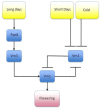Systems Modeling at Multiple Levels of Regulation: Linking Systems and Genetic Networks to Spatially Explicit Plant Populations
- PMID: 27137364
- PMCID: PMC4844292
- DOI: 10.3390/plants2010016
Systems Modeling at Multiple Levels of Regulation: Linking Systems and Genetic Networks to Spatially Explicit Plant Populations
Abstract
Selection and adaptation of individuals to their underlying environments are highly dynamical processes, encompassing interactions between the individual and its seasonally changing environment, synergistic or antagonistic interactions between individuals and interactions amongst the regulatory genes within the individual. Plants are useful organisms to study within systems modeling because their sedentary nature simplifies interactions between individuals and the environment, and many important plant processes such as germination or flowering are dependent on annual cycles which can be disrupted by climate behavior. Sedentism makes plants relevant candidates for spatially explicit modeling that is tied in with dynamical environments. We propose that in order to fully understand the complexities behind plant adaptation, a system that couples aspects from systems biology with population and landscape genetics is required. A suitable system could be represented by spatially explicit individual-based models where the virtual individuals are located within time-variable heterogeneous environments and contain mutable regulatory gene networks. These networks could directly interact with the environment, and should provide a useful approach to studying plant adaptation.
Keywords: gene regulatory networks; landscape genetics; population genetics; simulation; spatial individual based modeling; systems biology.
Figures




Similar articles
-
How to model and simulate the effects of cropping systems on population dynamics and gene flow at the landscape level: example of oilseed rape volunteers and their role for co-existence of GM and non-GM crops.Environ Sci Pollut Res Int. 2009 May;16(3):348-60. doi: 10.1007/s11356-008-0080-6. Epub 2008 Dec 9. Environ Sci Pollut Res Int. 2009. PMID: 19067013
-
Deciphering the adjustment between environment and life history in annuals: lessons from a geographically-explicit approach in Arabidopsis thaliana.PLoS One. 2014 Feb 3;9(2):e87836. doi: 10.1371/journal.pone.0087836. eCollection 2014. PLoS One. 2014. PMID: 24498381 Free PMC article.
-
Modeling the Epigenetic Landscape in Plant Development.Methods Mol Biol. 2018;1819:357-383. doi: 10.1007/978-1-4939-8618-7_17. Methods Mol Biol. 2018. PMID: 30421413
-
Genotypes, Networks, Phenotypes: Moving Toward Plant Systems Genetics.Annu Rev Cell Dev Biol. 2016 Oct 6;32:103-126. doi: 10.1146/annurev-cellbio-111315-124922. Epub 2016 Aug 3. Annu Rev Cell Dev Biol. 2016. PMID: 27501448 Review.
-
Green systems biology - From single genomes, proteomes and metabolomes to ecosystems research and biotechnology.J Proteomics. 2011 Dec 10;75(1):284-305. doi: 10.1016/j.jprot.2011.07.010. Epub 2011 Jul 23. J Proteomics. 2011. PMID: 21802534 Review.
Cited by
-
Surprisingly Low Limits of Selection in Plant Domestication.Evol Bioinform Online. 2016 Apr 5;11(Suppl 2):41-51. doi: 10.4137/EBO.S33495. eCollection 2015. Evol Bioinform Online. 2016. PMID: 27081302 Free PMC article.
-
Using archaeogenomic and computational approaches to unravel the history of local adaptation in crops.Philos Trans R Soc Lond B Biol Sci. 2015 Jan 19;370(1660):20130377. doi: 10.1098/rstb.2013.0377. Philos Trans R Soc Lond B Biol Sci. 2015. PMID: 25487329 Free PMC article. Review.
References
Publication types
LinkOut - more resources
Full Text Sources
Other Literature Sources

